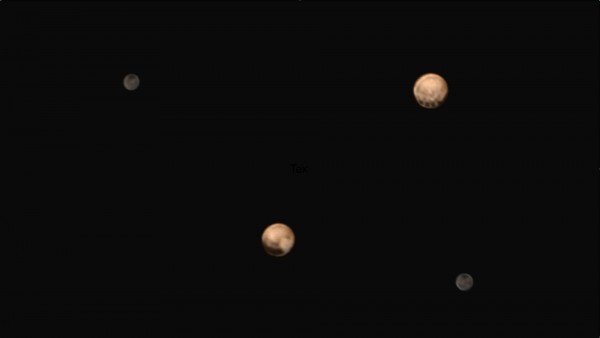
First there were the unusual bright spots on Ceres, which are still awaiting an explanation, and now as New Horizons races toward its flyby encounter with Pluto on July 14, another mystery has emerged: four intriguing large dark spots more or less along Pluto’s equator which seem to be roughly the same size and evenly spaced. The spots are mentioned as part of an update today from NASA about the “two different faces of Pluto” that scientists are now starting to see in more detail.
The new color images, taken on June 25 and June 27, show two different hemispheres of Pluto: the encounter hemisphere which will be seen in the most detail during the flyby and the opposite hemisphere. The images were produced by combining black-and-white images of Pluto and its largest moon Charon from the spacecraft’s Long-Range Reconnaissance Imager (LORRI) with lower-resolution color data from the Ralph instrument. The images are approximately true color, as in how a human eye would see Pluto and Charon. Due to Pluto’s orientation in the images, the equator is near the bottom.
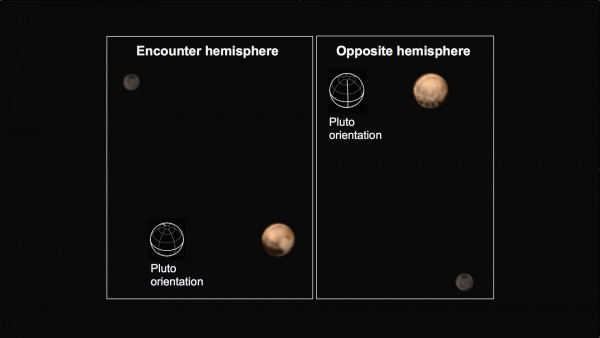
As for the spots, “It’s a real puzzle – we don’t know what the spots are, and we can’t wait to find out,” said New Horizons principal investigator Alan Stern of the Southwest Research Institute, Boulder. “Also puzzling is the longstanding and dramatic difference in the colors and appearance of Pluto compared to its darker and grayer moon Charon.”
Each of the intriguing dark spots is estimated to be approximately 300 miles across and about the size of the state of Missouri. They also appear to be generally evenly spaced along the equator, which may provide clues as to their formation. As New Horizons gets closer of course, the resolution of the images will increase greatly.
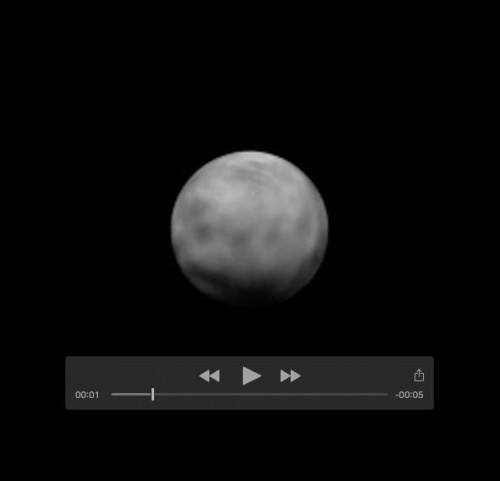
An excellent Pluto rotation animation by Björn Jónsson also show the four interesting dark spots (thanks to Björn Jónsson for usage).
Apart from the spots, the images are starting to show a lot more surface detail, with significant albedo variations visible on both Pluto and Charon. Charon interestingly also has a dark spot at one of its poles.
Scientists are also looking for signs of clouds in Pluto’s thin atmosphere. Both the high-resolution LORRI imager and the Ralph color imager will be used to look for clouds across the face of Pluto during its approach and departure from the planet. “We’re looking for clouds in our images using a number of techniques,” said science team postdoc Kelsi Singer of the Southwest Research Institute. “If we find clouds, their presence will allow us to track the speeds and directions of Pluto’s winds.”
Pluto’s atmosphere is known to periodically freeze onto the surface, raising concerns that it might not be there during the time of New Horizons’ encounter, but it was confirmed this week that the atmosphere is currently still active, according to observations from ground-based telescopes and NASA’s SOFIA airborne observatory.
“Pluto’s atmosphere is alive and well, and has not frozen out on the surface,” according to New Horizons deputy project scientist Leslie Young, Southwest Research Institute, Boulder. “We’re delighted!”
“The SOFIA observations will also be essential for linking ground-based studies to the results from the New Horizons Pluto encounter for decades to come,” said Cathy Olkin, Southwest Research Institute, Boulder, co-investigator on NASA’s New Horizons mission.
New Horizons has also detected frozen methane on Pluto’s surface; this is not a new discovery, but does confirm earlier Earth-based observations.
Also, the Pluto Energetic Particle Spectrometer Science Investigation (PEPSSI) instrument aboard New Horizons is busy sampling the space environment near Pluto. PEPSSI is designed to detect ions (atoms that have lost or gained one or more electrons) that have escaped from Pluto’s atmosphere. As they depart, these atoms become caught up in the solar wind, the stream of subatomic particles that emanates from the Sun. PEPSSI will tell scientists about the composition of Pluto’s escaping atmosphere and how quickly the atmosphere is escaping.
At this time, New Horizons is now less than 9.5 million miles (15 million kilometers) from the Pluto system. More information about the New Horizons mission is available here.
Want to keep up-to-date with all things space? Be sure to “Like” AmericaSpace on Facebook and follow us on Twitter: @AmericaSpace
Missions » New Horizons »



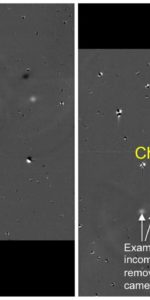
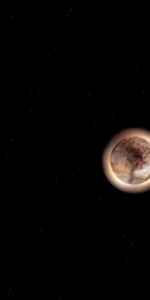
I should have read the caption stating “Still frame from Pluto rotation animation..” before I started clicking it and wondering why it didn’t work…..
Anyways, the color photo is jaw-dropping. I am happy not only for the wealth of knowledge that this mission continues to present us, but also for the men and woman who have worked very hard to get New Horizons off the ground and been very patient as it took its 9+ year journey to Pluto. Pluto may be small, but it is hugely important to figuring out more about our early solar system.
The sheer genius of this mission is incredible.
It would be interesting to see a time-lapse video of the approach, fly by and look back by New Horizons – similar to the ones done for the Mars rovers. Any idea if that is in the works?